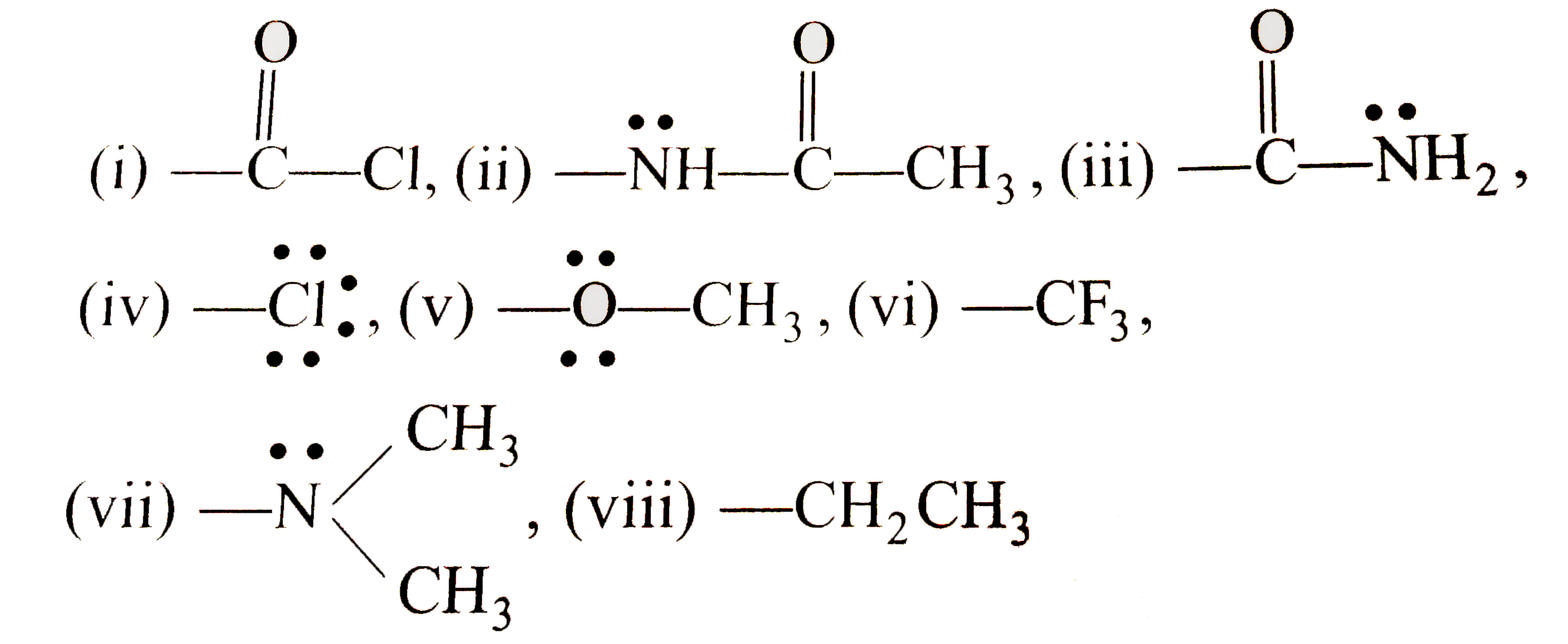Classify the following groups as ortho, para or meta directing when present on benzene nucleus.
(i) −CH3,(ii)−NH2, (iii) −NO2, (iv)−COOH, (v) −OH, (vi) −SO3H,
(vii) −X(halogen),
(viii) OCH3, (ix) −CHO, (x) −CN
(B) Classify the following goups as activating or deactivating with respect to further electrophilic substitution of the aromatic ring.
(i) −NH2 (ii) −NO2 (iii) −SO3H, (iv) −CH3 (v) −CI, (vi)−CN.
( C) For each of the following substituents indicate whether in donate electron or withdraw electron.

The correct Answer is:O- and p-directing groups :
(i), (ii), (v), (vii) and (viii)
meta-directing groups :
(iii), (iv), (vi), (ix) and (x)
Activating grups : (i) and (iv)
Deacting groups : (ii), (iii), (v) and (vi)
EDG : (ii), (v), and (viii)
EWG : (i), (iii), (iv) and (vi)
Topper's Solved these Questions
Similar Questions
Knowledge Check
Which of the following is a Bronsted base ?
(i) NH3 , (ii) CH3NH2
(iii) HCO−3 , (iv) SO2−4A(i), (ii), (iii), (iv)B(i), (ii)C(i), (ii), (iv)D(ii), (iii), (iv)Decreasing −I effect of given groups is :
(i) −CN (ii)−NO2 (iii)−NH2 (iv)−FAiii>ii>i>ivBii>iii>iv>iCiii>ii>iv>iDii>i>iv>iiiWhich of the following solvents are aprotic ?
(1)NH3 (2)SO2
(3)CH3CN (4)CH3CO2HA1,2,3B1,3,4C2,3D1,3
Classify the following into polar and non-polar molecules:
(i) CO2, (ii) CHCI3, (iii) CCI4, (iv) CH3OCH3,
(v) C2H5OH, (vi) C2H6, (vii) CH2CI2, (viii) NH3, (ix) H2O, (x) CH3CI.
View SolutionGive the conjugate base of (i)H2O , (ii)HNO3 , (iii)HI , (iv)NH+4 , (v) HCO−3 , (vi) OH−
View SolutionClassify the following into acid, base and amphiprotic in terms of protonic concept.
Н_(2)РО_(2)
(ii) H2PO3
(iii) H2APO4
(iv) HPO3
(V) HPO4
(vi) NH4 (vii) CH3COOH2
View SolutionHow many groups are ortho/para director in the electrophillic aromatic substitution?
(i) −NH2(ii)−COH(iii)−N=O(iv)−COOH
(v)−Et(vi)−N=NH2(vii)−SO3H
(viii) −O−C∣∣O−Ome(ix)
−O∣∣C−NH−Me
View SolutionHow many groups are ortho/para director in the electrophillic aromatic substitution?
(i) −NH2(ii)−COH(iii)−N=O(iv)−COOH
(v)−Et(vi)−N=NH2(vii)−SO3H
(viii) −O−C∣∣O−Ome(ix)
−O∣∣C−NH−Me
View Solution
